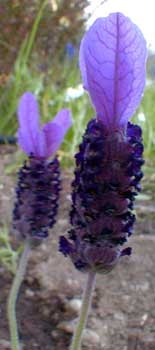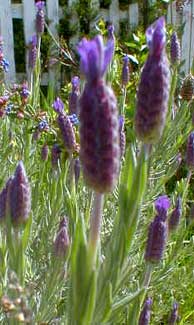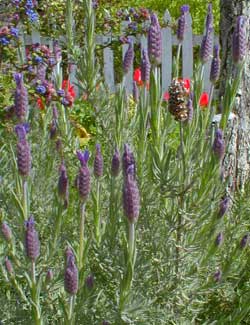 'Otto Quast'
'Otto Quast'
Spanish Lavender
"Make her bed with linen sheets
That have lain in lavender."
Agnes Mary Frances Darmesteter
(1857-1944)
That have lain in lavender."
Agnes Mary Frances Darmesteter
(1857-1944)
Hardy only in zones 8-9, & tender in zone 7, here on Puget Sound (zone 8) 'Otto Quast' requires a full-sun location, in ultra-well-draining soil, without too much organic matter because it thrives best in poorer soils.
 A brand new planting may need some carefully timed moderate waterings for a while, not so much as to keep it damp; but once established, our natural rain patterns sustain it, making it ideal for places in the garden beyond easy reach of hoses.
A brand new planting may need some carefully timed moderate waterings for a while, not so much as to keep it damp; but once established, our natural rain patterns sustain it, making it ideal for places in the garden beyond easy reach of hoses.'Otto Quast' has darker than average flowers. The woolybear-like part of the flower is a very deep indigo or purple-black. The sterile bracts that form a bow-tie atop the bloom are an almost transluscent rich purple with a touch of pink to them & tracings of veins.
The regular Spanish lavender lacks so striking a bi-color bloom, being purple for both the small petals & large bracts. 'Otto Quast' tends also to remain a bit shorter, eighteen inches to two feet to tip of flowers, & has a purer light green foliage rather than bluish green.
It blooms splendidly mid or late April right on through the whole of summer & lingering into autumn. Occasional deadheading is not necessary, but may help insure blooms last the maximum number of months. When the flowers have definitely quit, the whole shrublet can be trimmed back a little so that it remains compact, but do not sheer too much, as it will provide an evergreen presence clear through winter.
 The April (2004) photo above shows a small cutting-start of 'Otto Quast,' which is planted alongside an equally small start of White Lavender for the sake of a startling contrast. It was small when the first photo was taken, but one year later it was be an impressive subshrub, the second & third photos being from April 2005.
The April (2004) photo above shows a small cutting-start of 'Otto Quast,' which is planted alongside an equally small start of White Lavender for the sake of a startling contrast. It was small when the first photo was taken, but one year later it was be an impressive subshrub, the second & third photos being from April 2005.If not restrained by the annual sheering, it can begin to be floppy rather than upright, though this is not necessarily a negative, as it looks quite natural reaching outward on all sides to an expanse of three feet for a single clump. But if sheered it does remain a tighter more upright clump.
The lifespan of any Spanish Lavender can be relatively short. If it begins to look woody & lifeless at the cente after four or five years, it is all but useless to try to divide it, & if sheered too deeply into the woody portion, it usually fails to grow back. But it is easily rooted fom cuttings & pot-grown for a while, so that when the parent is well beyond its prime, it can be replaced. This cultivar will not grow true from seed; I have seen some alleged 'Otto Quest' lavenders grown from seed, & they did not have the remarkable bicolor effect.
It's named for nurseryman Otto Quast (1924-1996) who created many new cultivars of sundry sorts of plants at his nursery in Port Reyes Station, California. He was born in Hamburg, Germany, & until an injury put an end to his work as a shipyard carpenter, he was only a hobby gardener. In his forced early retirement, he became a professional plantsman from the 1960s until his death, so that to a surprising extent, an injury became a blessing.